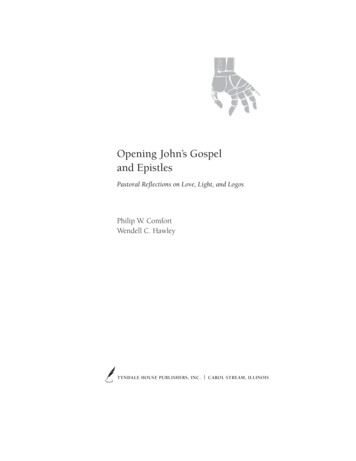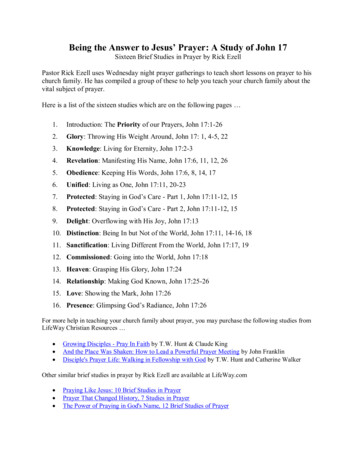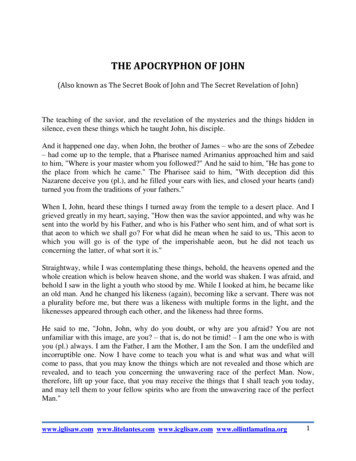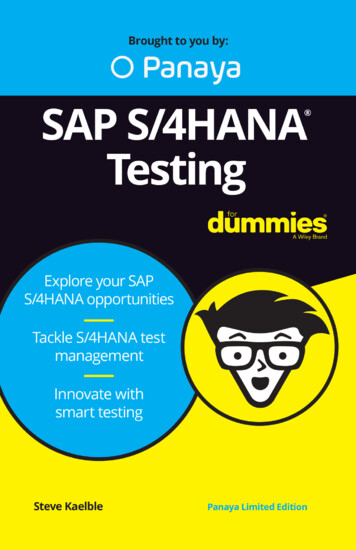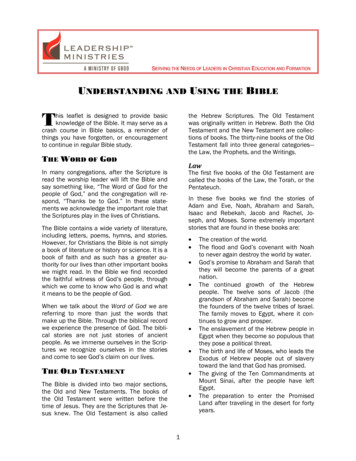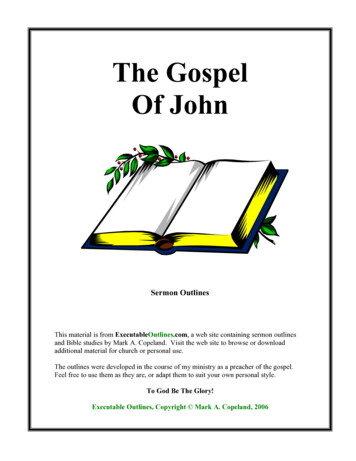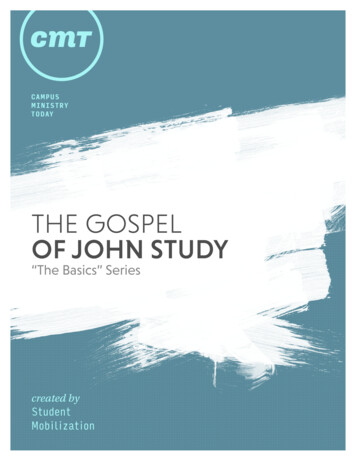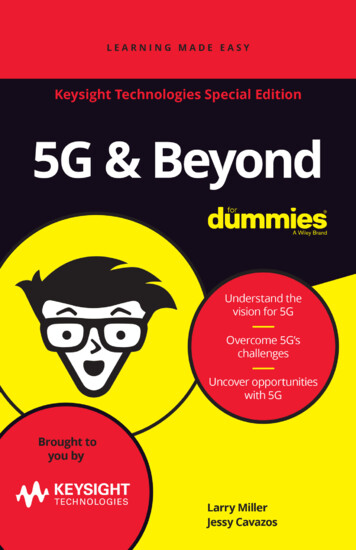
Transcription
These materials are 2022 John Wiley & Sons, Inc. Any dissemination, distribution, or unauthorized use is strictly prohibited.
5G &BeyondKeysight Technologies Special Editionby Larry Miller and Jessy CavazosThese materials are 2022 John Wiley & Sons, Inc. Any dissemination, distribution, or unauthorized use is strictly prohibited.
5G & Beyond For Dummies , Keysight Technologies Special EditionPublished byJohn Wiley & Sons, Inc.111 River St.Hoboken, NJ 07030-5774www.wiley.comCopyright 2022 by John Wiley & Sons, Inc., Hoboken, New JerseyNo part of this publication may be reproduced, stored in a retrieval system or transmitted in any formor by any means, electronic, mechanical, photocopying, recording, scanning or otherwise, exceptas permitted under Sections 107 or 108 of the 1976 United States Copyright Act, without the priorwritten permission of the Publisher. Requests to the Publisher for permission should be addressedto the Permissions Department, John Wiley & Sons, Inc., 111 River Street, Hoboken, NJ 07030,(201) 748-6011, fax (201) 748-6008, or online at http://www.wiley.com/go/permissions.Trademarks: Wiley, For Dummies, the Dummies Man logo, The Dummies Way, Dummies.com, MakingEverything Easier, and related trade dress are trademarks or registered trademarks of John Wiley & Sons,Inc. and/or its affiliates in the United States and other countries, and may not be used without writtenpermission. Keysight and the Keysight logo are trademarks or registered trademarks of KeysightTechnologies, Inc. All other trademarks are the property of their respective owners. John Wiley & Sons,Inc., is not associated with any product or vendor mentioned in this book.LIMIT OF LIABILITY/DISCLAIMER OF WARRANTY: WHILE THE PUBLISHER AND AUTHORS HAVEUSED THEIR BEST EFFORTS IN PREPARING THIS WORK, THEY MAKE NO REPRESENTATIONSOR WARRANTIES WITH RESPECT TO THE ACCURACY OR COMPLETENESS OF THE CONTENTS OFTHIS WORK AND SPECIFICALLY DISCLAIM ALL WARRANTIES, INCLUDING WITHOUT LIMITATIONANY IMPLIED WARRANTIES OF MERCHANTABILITY OR FITNESS FOR A PARTICULAR PURPOSE.NO WARRANTY MAY BE CREATED OR EXTENDED BY SALES REPRESENTATIVES, WRITTENSALES MATERIALS OR PROMOTIONAL STATEMENTS FOR THIS WORK. THE FACT THAT ANORGANIZATION, WEBSITE, OR PRODUCT IS REFERRED TO IN THIS WORK AS A CITATION AND/OR POTENTIAL SOURCE OF FURTHER INFORMATION DOES NOT MEAN THAT THE PUBLISHERAND AUTHORS ENDORSE THE INFORMATION OR SERVICES THE ORGANIZATION, WEBSITE, ORPRODUCT MAY PROVIDE OR RECOMMENDATIONS IT MAY MAKE. THIS WORK IS SOLD WITHTHE UNDERSTANDING THAT THE PUBLISHER IS NOT ENGAGED IN RENDERING PROFESSIONALSERVICES. THE ADVICE AND STRATEGIES CONTAINED HEREIN MAY NOT BE SUITABLE FORYOUR SITUATION. YOU SHOULD CONSULT WITH A SPECIALIST WHERE APPROPRIATE. FURTHER,READERS SHOULD BE AWARE THAT WEBSITES LISTED IN THIS WORK MAY HAVE CHANGEDOR DISAPPEARED BETWEEN WHEN THIS WORK WAS WRITTEN AND WHEN IT IS READ.NEITHER THE PUBLISHER NOR AUTHORS SHALL BE LIABLE FOR ANY LOSS OF PROFIT OR ANYOTHER COMMERCIAL DAMAGES, INCLUDING BUT NOT LIMITED TO SPECIAL, INCIDENTAL,CONSEQUENTIAL, OR OTHER DAMAGES.ISBN 978-1-119-69362-8; ISBN 978-1-119-69364-2 (ebk)Publisher’s AcknowledgmentsFor general information on our other products and services, or how to create acustom For Dummies book for your business or organization, please contact ourBusiness Development Department in the U.S. at 877-409-4177, contact info@dummies.biz, or visit www.wiley.com/go/custompub. Some of the people whohelped bring this book to market include the following:Project Manager and DevelopmentEditor: Chad R. SieversBusiness Development Representative:Matt CoxAcquisitions Editor: Ashley CoffeyProduction Editor:Tamilmani VaradharajEditorial Manager: Rev MengleThese materials are 2022 John Wiley & Sons, Inc. Any dissemination, distribution, or unauthorized use is strictly prohibited.
Table of ContentsINTRODUCTION. 1About This Book. 1Foolish Assumptions. 1Icons Used in This Book. 2Beyond the Book. 2CHAPTER 1:Realizing the Vision of 5G. 3Looking at 5G New Radio (NR). 3Vision. 4Use cases. 43GPP 5G releases. 5Evolution to Release 16. 9Smoothing the Migration Path to the 5G Vision. 10From 5G NSA to SA. 10From FR1 to mmWave FR2. 11From traditional RAN to O-RAN. 11CHAPTER 2:Stepping Up 5G Device and Base StationDevelopment. 13Integrating and Optimizing 5G Devices. 13Device development. 14Device conformance. 14Device acceptance. 15Ramping Up Device Manufacturing. 16Optimizing gNB Performance. 17CHAPTER 3:Accelerating the Transformation to O-RAN. 19Overcoming Traditional RAN Challenges. 19Understanding O-RAN Basics. 22Addressing conformance and integration challenges. 24Deploying O-RAN. 24Table of ContentsiiiThese materials are 2022 John Wiley & Sons, Inc. Any dissemination, distribution, or unauthorized use is strictly prohibited.
CHAPTER 4:Advancing Virtualization, Cloudification,and MEC. 25Evolving from 5G NSA to SA. 25Embracing MEC. 26Enabling 5G Observability. 27Ensuring Security. 28CHAPTER 5:Expanding Wireless Connectivity toEnable Innovation. 29Recognizing New Opportunities. 29New services. 29New industries. 30New revenue streams. 31Defining the 6G Vision. 31CHAPTER 6:Ten Steps to 5G Deployment Success. 35GLOSSARY. 37iv5G & Beyond For Dummies, Keysight Technologies Special EditionThese materials are 2022 John Wiley & Sons, Inc. Any dissemination, distribution, or unauthorized use is strictly prohibited.
IntroductionThe promise of 5G is faster and more reliable communications. 5G enables the Internet of Things (IoT), autonomousvehicles, wireless broadband, interruption-free video, andthe fourth industrial revolution. When you develop 5G technology,understanding design and testing concepts and solutions acrossmultiple dimensions is imperative.In this book, you find out about 5G technologies and their associated challenges. You also discover solutions available to addressthese challenges and ways you can create new opportunities foryour organization.About This Book5G & Beyond For Dummies, Keysight Technologies Special Edition,describes how 5G technologies are evolving. This book is conven iently organized into six chapters that»» Explain the vision of 5G New Radio (NR) and the path to the5G vision (Chapter 1)»» Describe 5G device and base station development (Chapter 2)»» Delve into Open Radio Access Network (O-RAN) challengesand solutions (Chapter 3)»» Detail virtualization, cloudification, multi-access edge computing(MEC), observability, and security trends in 5G (Chapter 4)»» Explore 5G opportunities and the vision for 6G (Chapter 5)»» List the key steps to 5G deployment success (Chapter 6)You can also refer to the glossary at the end of the book — just incase you start feeling overwhelmed by any acronyms or technicalterms used in this book.Foolish AssumptionsThis book uses mainly one assumption about you: You’re an engineer of some sort within the mobile ecosystem. Perhaps you workIntroduction1These materials are 2022 John Wiley & Sons, Inc. Any dissemination, distribution, or unauthorized use is strictly prohibited.
for a chipset manufacturer, device maker, network equipment manufacturer, or network operator involved in the research, development, and manufacturing of 5G devices (such as chipsets, devices,base stations, or components) or the deployment of 5G networks.You probably know a little something about wireless communications, but you may not necessarily know about the latest 5G technologies. As such, this book is primarily for technical readers.If that describes you, you’re in the right place. If it doesn’t, keepreading anyway. It’s a great book, and you’ll find out a few thingsabout 5G.Icons Used in This BookThis book occasionally uses icons to call attention to importantinformation. Here’s what you can expect:This icon points out information or a concept that may well beworth committing to your nonvolatile memory, your gray matter,or your noggin!If you seek to attain the seventh level of nerd-vana, perk up!This icon explains the jargon beneath the jargon and is the stufflegends — well, nerds — are made of.Tips are appreciated, but never expected — so keep these usefulnuggets of information nearby.These alerts point out the stuff your mother warned you about(well, probably not). But they do offer practical advice to help youavoid potentially costly mistakes.Beyond the BookThere’s only so much this short book covers, so if you findyourself wondering, “Where can I find out more?,” just go towww.keysight.com/find/5g.25G & Beyond For Dummies, Keysight Technologies Special EditionThese materials are 2022 John Wiley & Sons, Inc. Any dissemination, distribution, or unauthorized use is strictly prohibited.
IN THIS CHAPTER»» Tuning in to 5G New Radio (NR)»» Plotting the path to 5GChapter1Realizing the Vision of 5GThe high-bandwidth and real-time capabilities of 5G holdenormous potential for society by enabling many new andunexpected use cases. In this chapter, you find out about the5G vision, discover more about use cases, read about standardsenhancements, and delve deeper into the migration path to 5G.Looking at 5G New Radio (NR)5G embodies the breadth and depth of innovative and comprehensive mobile wireless communications technology. The potential of 5G goes well beyond that of its predecessors. Some of thenew applications it will enable are»» Multi-gigabit wireless mobile broadband»» Fixed broadband wireless access»» Augmented reality (AR) and virtual reality (VR)»» Autonomous vehicles»» Vehicle-to-everything (V2X) communications»» The mobile Internet of Things (IoT)»» The wireless industrial IoT (IIoT)CHAPTER 1 Realizing the Vision of 5G3These materials are 2022 John Wiley & Sons, Inc. Any dissemination, distribution, or unauthorized use is strictly prohibited.
NR is to 5G what Long Term Evolution (LTE) is to 4G. The 5G NRstandard continues to evolve to enable faster data rates, improvedcoverage, lower latency, higher reliability, and greater networkflexibility.The following sections break down the ins and outs of 5G to helpyou better understand the importance of the technology from atechnical standpoint.VisionThe vision for the 5G future is bold: It’s much more than just thenext iteration of mobile networks. Technological trends includingcloud computing, artificial intelligence (AI) and machine learning(ML), AR and VR, and billions of connected devices are pushingthe boundaries of the wireless communications system like neverbefore.5G technology promises faster, more reliable, and near-instantconnections that will universally connect people and things. 5Gallows everyone to experience live events and video games in realtime, make phone and video calls that feel close and intimate, andpair smart devices with AI to create a customized and personalized environment for everyone.Use casesThe three use cases defined in 5G NR are as follows:»» Enhanced mobile broadband (eMBB): eMBB refers to thetarget 5G peak and average data rates, capacity, andcoverage as compared to conventional mobile broadband.eMBB specifies a 5G design capable of supporting up to 20gigabits per second (Gbps) in the downlink (DL) and 10 Gbpsin the uplink (UL).»» Massive machine-type communications (mMTC): mMTCsupports 5G IoT use cases with billions of connected devicesand sensors. The use case covers both low-data-rate/low-bandwidth devices with infrequent bursts of datarequiring long battery life as well as very-high-bandwidth/data-rate devices.»» Ultra-reliable and low-latency communications (URLLC):URLLC focuses on applications that require fail-safe,45G & Beyond For Dummies, Keysight Technologies Special EditionThese materials are 2022 John Wiley & Sons, Inc. Any dissemination, distribution, or unauthorized use is strictly prohibited.
real-time communications. Examples include autonomousvehicles, the industrial Internet, smart grids, infrastructureprotection, and intelligent transportation systems.3GPP 5G releasesThe 3rd Generation Partnership Project (3GPP) is an industryconsortium responsible for developing standards for mobile telecommunications (protocols, architectures, system requirements,and so on). Release 15 (Rel-15) of the 5G NR specification is thefirst implementable standard for 5G, and it establishes a flexiblefoundation to accommodate future releases of 5G features.Rel-15 focuses on the high-speed data rates and capacity demandsof eMBB. It specifies a new air interface to enable higher datathroughput and lays the groundwork for low latency and higherreliability applications. The use of millimeter-wave (mmWave)spectrum up to 52.6 gigahertz (GHz) is the key to enabling higherdata throughput. At these higher frequencies, more contiguousspectrum is available to send more data through the channel.Rel-15 specifies a maximum carrier bandwidth of up to 400 megahertz (MHz) and up to 16 component carriers (CCs), and allowsmultiple carriers to be combined to create up to 800 MHz of channel bandwidth. Flexibility and scalability in the slot structure helpsupport the many new and diverse use cases expected from 5G.Figure 1-1 reviews some of the key technologies and benefits in5G NR Rel-15 that are discussed in the following sections.FIGURE 1-1: 5G NR Rel-15 technologies and their benefits.Low latencyThe URLLC use case is partially achieved through a conceptcalled mini-slots. In LTE, transmissions adhere to the standardslot boundaries, but they aren’t optimized for minimal latency.CHAPTER 1 Realizing the Vision of 5G5These materials are 2022 John Wiley & Sons, Inc. Any dissemination, distribution, or unauthorized use is strictly prohibited.
A standard slot has 14 orthogonal frequency-division multiplexing (OFDM) symbols. As the subcarrier spacing increases, theslot duration decreases. A mini-slot is shorter in duration than astandard slot and can be located anywhere within the slot. A minislot is two, four, or seven OFDM symbols long. Mini-slots providelow latency payloads with an immediate start time, without needing to wait for the start of a slot boundary.FlexibilityThe maximum carrier bandwidth in LTE is 20 MHz, which whenaggregated across the maximum number of carriers that thestandard allows — five — creates a wider effective communication channel bandwidth of up to 100 MHz. In 5G NR, the maximum carrier bandwidth is up to 100 MHz in FR1 (up to 7.125 GHz),or up to 400 MHz in FR2 (24.25 to 52.6 GHz). The standard allowsfor the aggregation of multiple carriers for up to 800 MHz ofchannel bandwidth.A new innovation in 5G NR is bandwidth parts, where the carrieris subdivided for different purposes. Each bandwidth part has itsown numerology and is signaled independently. One carrier canhave mixed numerologies to support services in unlicensed bandsand different levels of services — like power saving or multiplexing of numerologies.Reliable channels5G NR uses the cyclic prefix OFDM (CP-OFDM) waveform format.Unlike LTE, this format can be used in both the DL and the UL.Having the same waveform in both the UL and the DL enableseasier implementation of things like device-to-device communication in future releases. Discrete Fourier transform spread OFDM(DFT-s-OFDM) is an optional waveform in the UL. DFT-s-OFDMreduces the demand on user equipment (UE) transmission amplifiers, helping to extend battery life.Unlike 4G, NR allows for scalable OFDM numerology where thesubcarrier spacings are no longer fixed to 15 kilohertz (kHz).Subcarrier spacing is determined by the formula 2n 15 kHzwhere n can be as low as –1. Lower frequency bands use 7.5, 15,30, and 60 kHz subcarrier spacings, and higher frequency bandsuse 60, 120, and 240 kHz subcarrier spacings.65G & Beyond For Dummies, Keysight Technologies Special EditionThese materials are 2022 John Wiley & Sons, Inc. Any dissemination, distribution, or unauthorized use is strictly prohibited.
Scalable numerology enables scalable slot duration to optimizethroughput, latency, or reliability for different service levels.Larger subcarrier spacing at higher frequencies also helps withthe robustness of the waveform because integrated phase noise isa greater issue in mmWave designs (see Figure 1-2).FIGURE 1-2: Relationship between subcarrier spacing and time duration.In an OFDM system, using CP mitigates the effects of channeldelay spread and intersymbol interference (ISI). CP provides abuffer to protect the OFDM signal from ISI by repeating the endof the symbol at the start of the same symbol. Although using CPreduces the achievable data rate, it eliminates ISI up to the lengthof the CP. In 5G NR, as subcarrier spacing changes, CP lengthscales to adapt to the channel conditions.Channel state information (CSI), which refers to the known properties of a communication link, helps with 5G NR beamformingreliability. 5G NR specifies a new beam management frameworkfor CSI acquisition to reduce coupling between CSI measurementsand reporting to control different beams dynamically. CSI useschannel estimation to intelligently change the precoding andadapt the beam to a specific user. The better and more precisethis CSI information, the better the link adaptation. CSI is alsoused for other purposes like equalization to adjust for frequencydepended variations within the transmit (Tx) channel.CHAPTER 1 Realizing the Vision of 5G7These materials are 2022 John Wiley & Sons, Inc. Any dissemination, distribution, or unauthorized use is strictly prohibited.
Greater throughput5G boosts throughput in multiple ways. For example:»» Wider overall channel bandwidths enable sending more datathrough the air interface.»» Spatial multiplexing sends multiple independent streams ofdata through multiple antennas at a given time and frequency and uses enhanced channel feedback.Enhanced channel feedback improves throughput because thesignal is optimized for transmission with advanced channel coding. Massive multiple-input/multiple-output (massive MIMO)and beam-steering technologies improve throughput.Operating at mmWave frequencies introduces new challengesin path loss, blockage, and signal reflections. Beam steering is akey technology to overcome these issues. NR specifies new initialaccess procedures to ensure alignment of the directional transmissions used in beam steering. New initial access techniques usebeam sweeping to have the base station transmit multiple beamsand then identify the strongest beam and establish a communication link. Validating initial access, beam management, andthroughput achieved through the wireless link are key factors forsuccessful beam steering implementation in 5G (see Figure 1-3).FIGURE 1-3: Beam sweeping and initial access concepts.85G & Beyond For Dummies, Keysight Technologies Special EditionThese materials are 2022 John Wiley & Sons, Inc. Any dissemination, distribution, or unauthorized use is strictly prohibited.
Evolution to Release 16The 5G NR standard continues to evolve with many new enhancements added in Release 16 (Rel-16) including:»» URLLC: Downlink and uplink enhancements, new prioritiza-tion and multiplexing, and multiple active configurations helpachieve lower latency, higher reliability, and support for newuse cases like motion control for factory automation andremote driving, and enhance Rel-15 use cases like AR/VR.»» Multi-access edge computing (MEC): Enabling lowerlatencies by moving things closer to the edge of the network,MEC is especially helpful for robotics, mission-criticalautonomous factories, and remote driving applications. Inaddition to protocol enhancements, Rel-16 implementsredundancy mechanisms and introduces a new intermediatesession management function (I-SMF) node to control theuser plane function (UPF) when the SMF isn’t able to.»» Wireless/wireline coexistence: New nodes improve interworking with non-3GPP systems for wireline access connectivity.Rel-16 adds support for trusted non-3GPP systems and thesimultaneous usage of 3GPP and non-3GPP systems.»» Interference management: Cross link interference (CLI)assesses and mitigates DL and UL cross-interferencebetween cells and UEs on the network. Remote interferencemanagement (RIM) helps the network understand andmitigate environmental (that is, atmospheric) issues.»» MIMO: New features and enhancements include support formulti-user MIMO (MU-MIMO) that increases capacity byallowing more UEs on the network, DL and UL controlsignaling for multi-beam operations to reduce latency andsignaling overhead, and UE power enhancements.»» Power efficiency: PDCCH lets a UE know when it needs tobecome active and when it can go inactive (or into sleepmode). MIMO layer adaption allows a UE to turn off unusedreceivers for longer periods of time to save power.»» Unlicensed spectrum: Rel-16 enables NR to operate in unli-censed spectrum through carrier aggregation (CA) with CCs inlicensed and unlicensed spectrum, dual connectivity (DC) with LTEin licensed spectrum and NR in unlicensed spectrum, full NRoperation in unlicensed spectrum, and NR cell with DL frequenciesin unlicensed spectrum and UL frequencies in licensed spectrum.CHAPTER 1 Realizing the Vision of 5G9These materials are 2022 John Wiley & Sons, Inc. Any dissemination, distribution, or unauthorized use is strictly prohibited.
Smoothing the Migration Pathto the 5G VisionNetwork operators are taking different paths to migrate to 5G. Thefirst networks and devices used 5G non-standalone (NSA) modeto accelerate deployment. Now that the standard for 5G standalone (SA) is complete, parts of the industry are moving to 5GSA. Sub-6 GHz 5G deployments are well underway across theglobe while mmWave networks are ramping up. Operators arealso looking to adopt open, virtualized, and cloud-based radioaccess networks (RAN) for greater network flexibility and savecosts. These evolutions are at the heart of the mobile networkevolution.From 5G NSA to SA5G can operate in NSA mode — using the existing 4G LTE radioand evolved packet core (EPC) network and eNodeB (eNB) asan anchor and control plane — or in SA mode — using 5G NRand connecting directly to the 5G next-generation core (NGC),operating independently of 4G (see Figure 1-4).FIGURE 1-4: 5G NR deployment options.105G & Beyond For Dummies, Keysight Technologies Special EditionThese materials are 2022 John Wiley & Sons, Inc. Any dissemination, distribution, or unauthorized use is strictly prohibited.
5G NR works alongside 4G and even utilizes the 4G core networkfor both data and control planes in NSA mode. 5G, 4G, and Wi-Fineed to coexist on the same carriers and utilize unlicensed bandsto increase capacity below 6 GHz. Chapter 4 discusses 5G NSA andSA in greater detail.From FR1 to mmWave FR2Spectrum harmonization across regions is limited. It’s challenging for designers to deliver the full range of capabilities andcoverage for consumers around the world. 5G NR specifies frequencies up to 52.6 GHz, and so far, 3GPP has specified associated behavior and performance to open up almost 10 GHz of newspectrum, as follows:»» Frequency range 1 (FR1): 410 MHz to 7.125 GHz adds1.5 GHz of new spectrum in frequency bands: 3.3–4.2 GHz,3.3–3.8 GHz, 4.4–5 GHz, and 5.925–7.125 GHz.»» Frequency range 2 (FR2): 24.25 to 52.6 GHz initially added8.25 GHz of new spectrum in frequency bands: 26.5–29.5GHz, 24.25–27.5 GHz, and 37–40 GHz.FR1 introduces new challenges for designs — especially in thenew bands above 3 GHz — due to additional propagation loss, thecomplexity of the test cases, coexistence issues, and the requiredvalidation of massive MIMO designs over the air.Similar to LTE, CA provides larger bandwidths, up to a maximum bandwidth of 800 MHz at FR2. (CA is also applicable to FR1frequencies although it increases complexity enormously.) Eachcountry decides on the amount of spectrum deployed. New frequency bands are defined and more CA combinations specified.From traditional RAN to O-RANThe desire for wireless operators to move their networks fromphysical purpose-built hardware to virtual and cloud-based software implementations emerged with 4G. This step to virtualization is well underway for the core network. The O-RAN Alliance isworking to achieve this goal for the RAN.CHAPTER 1 Realizing the Vision of 5G11These materials are 2022 John Wiley & Sons, Inc. Any dissemination, distribution, or unauthorized use is strictly prohibited.
The group is specifying the discrete elements of a disaggregatedbase station in the RAN and is standardizing interfaces betweenthem to allow hosting on white-box hardware instead of purposebuilt appliances. This not only allows for easier virtualization ofthe digital elements of the architecture, but it also opens the doorfor operators to work with a multitude of vendors that excel intheir area of focus. Each subcomponent of Open Radio AccessNetwork (O-RAN) — even pieces within subcomponents — cancome from a different vendor.Read Chapter 3 to find out more about O-RAN.125G & Beyond For Dummies, Keysight Technologies Special EditionThese materials are 2022 John Wiley & Sons, Inc. Any dissemination, distribution, or unauthorized use is strictly prohibited.
IN THIS CHAPTER»» Looking at device development,conformance, and acceptance»» Accelerating time to market in devicemanufacturing»» Maximizing performance in the basestationChapter2Stepping Up 5G Deviceand Base StationDevelopmentIt’s an exciting time to be in the wireless industry. The race is onto deploy 5G. New chipsets, devices, and base stations need tobe rolled out at the right cost and time. In this chapter, you findout how to accelerate time to market across your product development life cycle.Integrating and Optimizing 5G Devices5G introduces new challenges related to the use of millimeterwave (mmWave) frequencies and beam management, driving theneed for validating complex, integrated next-generation devicesin over-the-air (OTA) test environments. Use cases for 5G alsocontinue to evolve, which means 5G devices need to be characterized and validated to comply with developing 3rd GenerationPartnership Project (3GPP) New Radio (NR) specifications andmobile operator acceptance plans.CHAPTER 2 Stepping Up 5G Device and Base Station Development13These materials are 2022 John Wiley & Sons, Inc. Any dissemination, distribution, or unauthorized use is strictly prohibited.
These sections discuss the key stages of the 5G device workflowfrom development to acceptance.Device developmentEvery new device carrying a 5G chipset comes with a list of tests.5G mobile devices also combine sub-6 gigahertz (GHz) bandswith new multiple-input/multiple-output (MIMO) antenna systems and mmWave bands with beam steering. Global spectrumassignments and deployment options expand the test matrix.A comprehensive suite of tools can help you accelerate your devicedevelopment cycle — pre-silicon, modem and radio frequency(RF) bring-up, mobile test platform, device integration, and performance optimization — across the protocol, RF, and functionaland performance test domains.Device conformancePassing conformance and device acceptance tests is a significantchallenge for 5G device and base station companies.Keep the following in mind when preparing for 5G NR conformance tests:»» Conformance test requirements and test methods continueto evolve as 3GPP refines and adds to the standards.»» Frequency range 2 (FR2: 24.25 to 52.6 GHz) significant
vehicles, the industrial Internet, smart grids, infrastructure protection, and intelligent transportation systems. 3GPP 5G releases The 3rd Generation Partnership Project (3GPP) is an industry consortium responsible for developing standards for mobile tele - communications (protocols, architectures, system requirements, and so on).

